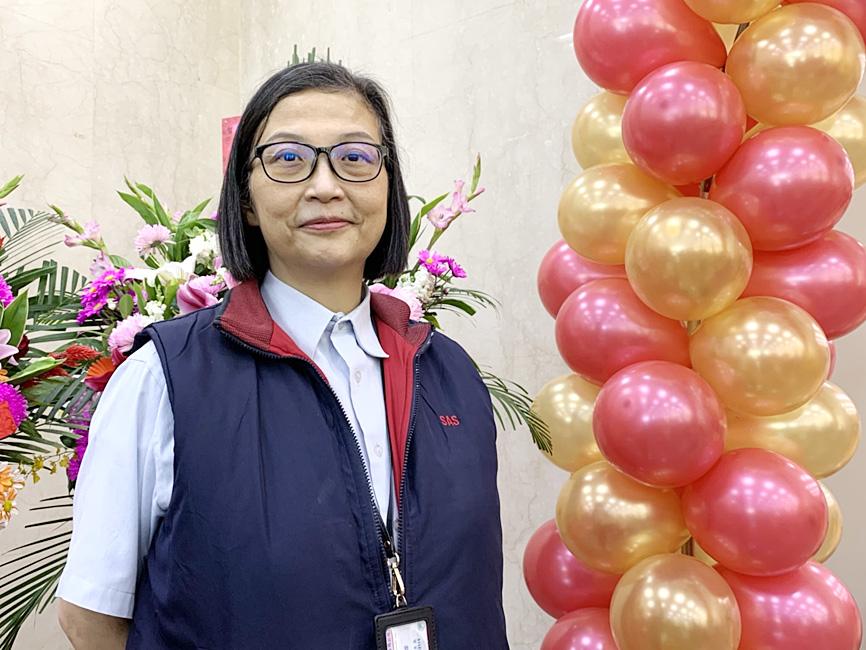Order visibility at GlobalWafers Inc (環球晶圓) extends into 2024 and its capacity for next year is fully booked, the world’s No. 3 silicon wafer supplier said yesterday.
GlobalWafers is trying to squeeze out extra capacity by increasing production efficiency, but the company is still unable to satisfy customer demand for next year, company chairwoman Doris Hsu (徐秀蘭) told reporters on the sidelines of a ceremony to mark the 41st anniversary of the Hsinchu Science Park (新竹科學園區).
“We have clear order visibility for 2023 and it should be okay into 2024,” Hsu said. “We do not see any signs of things slowing down in 2023 or 2024.”

Photo: Grace Hung, Taipei Times
The firm has received more than NT$100 billion (US$3.6 billion) in orders, Hsu said.
To secure a stable wafer supply, many customers are signing longer supply agreements, from five years in 2007 — when its made-to-order strategy was first introduced — to eight years now, GlobalWafers said.
Although segments have their ups and downs, a weak segment, such as smartphones, is soon offset by the upswing of another segment, such as cars or 5G-related applications, Hsu said.
GlobalWafers said that it expects its factories to remain fully utilized through 2024, mainly because capacity expansion worldwide moves at a snail’s pace.
“The major task of our salespeople is to explain to customers why we can only fulfill 90 percent of their demand,” Hsu said. “GlobalWafers is not the only company in the world that is facing a supply challenge.”
Global shipments of silicon wafers are expected to see annual growth of 6.4 percent next year, 4.6 percent in 2023 and 2.9 percent in 2024, GlobalWafers said.
To expand capacity, GlobalWafers said it would over the next two years invest US$800 million on improving production efficiency at its 12-inch fabs, including those in the US.
Hsu declined to comment on wafer prices, but said that GlobalWafers factors spikes in manufacturing costs into its product pricing.
The cost of transportation and raw materials, including chemicals, have been increasing since the emergence of COVID-19, amid port gridlock, a container shortage and temporary shutdowns at factories.
The company expects the EU’s introduction of a carbon border tax in 2026 to add to its manufacturing costs, as importers and manufacturers outside the EU would have to pay for the carbon emissions linked to the goods and materials they sell in the eurozone, Hsu said.

Shares in Taiwan closed at a new high yesterday, the first trading day of the new year, as contract chipmaker Taiwan Semiconductor Manufacturing Co (TSMC, 台積電) continued to break records amid an artificial intelligence (AI) boom, dealers said. The TAIEX closed up 386.21 points, or 1.33 percent, at 29,349.81, with turnover totaling NT$648.844 billion (US$20.65 billion). “Judging from a stronger Taiwan dollar against the US dollar, I think foreign institutional investors returned from the holidays and brought funds into the local market,” Concord Securities Co (康和證券) analyst Kerry Huang (黃志祺) said. “Foreign investors just rebuilt their positions with TSMC as their top target,

REVENUE PERFORMANCE: Cloud and network products, and electronic components saw strong increases, while smart consumer electronics and computing products fell Hon Hai Precision Industry Co (鴻海精密) yesterday posted 26.51 percent quarterly growth in revenue for last quarter to NT$2.6 trillion (US$82.44 billion), the strongest on record for the period and above expectations, but the company forecast a slight revenue dip this quarter due to seasonal factors. On an annual basis, revenue last quarter grew 22.07 percent, the company said. Analysts on average estimated about NT$2.4 trillion increase. Hon Hai, which assembles servers for Nvidia Corp and iPhones for Apple Inc, is expanding its capacity in the US, adding artificial intelligence (AI) server production in Wisconsin and Texas, where it operates established campuses. This

US President Donald Trump on Friday blocked US photonics firm HieFo Corp’s US$3 million acquisition of assets in New Jersey-based aerospace and defense specialist Emcore Corp, citing national security and China-related concerns. In an order released by the White House, Trump said HieFo was “controlled by a citizen of the People’s Republic of China” and that its 2024 acquisition of Emcore’s businesses led the US president to believe that it might “take action that threatens to impair the national security of the United States.” The order did not name the person or detail Trump’s concerns. “The Transaction is hereby prohibited,”

Garment maker Makalot Industrial Co (聚陽) yesterday reported lower-than-expected fourth-quarter revenue of NT$7.93 billion (US$251.44 million), down 9.48 percent from NT$8.76 billion a year earlier. On a quarterly basis, revenue fell 10.83 percent from NT$8.89 billion, company data showed. The figure was also lower than market expectations of NT$8.05 billion, according to data compiled by Yuanta Securities Investment and Consulting Co (元大投顧), which had projected NT$8.22 billion. Makalot’s revenue this quarter would likely increase by a mid-teens percentage as the industry is entering its high season, Yuanta said. Overall, Makalot’s revenue last year totaled NT$34.43 billion, down 3.08 percent from its record NT$35.52